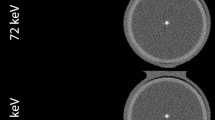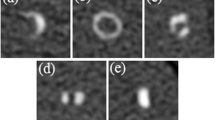Abstract
X-ray computed tomography (CT) remains the only in vivo method for the quantification of coronary calcifications (Wexler et al. 1996). To date, a whole number of different CT techniques for the quantification of coronary calcification has been described (Table 4.4.1).
Access this chapter
Tax calculation will be finalised at checkout
Purchases are for personal use only
Preview
Unable to display preview. Download preview PDF.
Similar content being viewed by others
References
Achenbach S, Ropers D, Mohlenkamp S et al (2001) Variability of repeated coronary artery calcium measurements by electron beam tomography. Am J Cardiol 87:210–213, A218
Agatston AS, Janowitz WR, Hildner FJ et al (1990) Quantification of coronary artery calcium using ultrafast computed tomography. J Am Coll Cardiol 15: 827–832
Becker CR, Kleffel T, Crispin A et al (2001) Coronary artery calcium measurement: agreement of multirow detector and electron beam ct. AJR Am J Roentgenol 176: 1295–1298
Bielak LF, Kaufmann RB, Moll PP et al (1994) Small lesions in the heart identified at electron beam ct: calcification or noise? Radiology 192: 631–636
Bielak LF, Sheedy PF, Peyser PA (2001) Coronary artery calcification measured at electron-beam CT: agreement in dual scan runs and change over time. Radiology 218: 224–229
Budoff MJ, Mao S, Zalace CP et al (2001) Comparison of spiral and electron beam tomography in the evaluation of coronary calcification in asymptomatic persons. Int J Cardiol 77: 181–188
Callister TQ,Cooil B,Raya SP et al (1998a) Coronary artery disease: improved reproducibility of calcium scoring with an electron-beam ct volumetric method. Radiology 208: 807–814
Callister TQ, Raggi P, Cooil B et al (1998b) Effect of hmg-coa reductase inhibitors on coronary artery disease as assessed by electron-beam computed tomography. N Engl J Med 339: 1972–1978
Carr JJ, Crouse JR 3rd, Goff DC Jr et al (2000) Evaluation of subsecond gated helical ct for quantification of coronary artery calcium and comparison with electron beam ct. Am J Roentgenol 174: 915–921
Detrano R, Kang X, Mahaisavariya P et al (1994) Accuracy of quantifying coronary hydroxyapatite with electron beam tomography. Invest Radiol 29: 733–738
Detrano R, Tang W, Kang X et al (1995) Accurate coronary calcium phosphate mass measurements from electron beam computed tomograms. Am J Card Imaging 9: 167–173
Dorland’s (1988) Illustrated medical dictionary, 27th edn. Saunders, Philadelphia
Erbel R, Moshage W (1999) Consensus protocol for the acquisition and interpretation of coronary calcium studies by electron beam CT in Germany. Z Kardiol 88: 459–465
Goldin JG, Yoon HC, Greaser LE et al (2001) Spiral versus electron-beam CT for coronary artery calcium scoring. Radiology 221: 213–221
Kaufmann RB, Sheedy PF, Breen JF et al (1994) Detection of heart calcification with electron beam ct: Interobserver and intraobserver reliability for scoring quantification. Radiology 190: 347–352
Knollmann FD, Halfmann R, Regn J et al (1999) Motion artifacts in cardiac CT. The Novacor left ventricular assist
device and its implications for clinical imaging. Acta Radiol 40:569–577
Knollmann FD, Bocksch W, Spiegelsberger S et al (2000) Electron-beam computed tomography in the assessment of coronary artery disease after heart transplantation. Circulation 101: 2078–2082
Mao S, Bakhsheshi H, Lu B et al (2001) Effect of electrocardiogram triggering on reproducibility of coronary artery calcium scoring. Radiology 220: 707–711
Mautner GC, Mautner SL, Froehlich J et al (1994) Coronary artery calcification: Assessment with electron beam ct and histomorphometric correlation. Radiology 192: 619–623
Mautner SL, Mautner GC, Froehlich J et al (1994) Coronary artery disease: prediction with in vitro electron beam CT. Radiology 192: 625–630
Rumberger JA, Simons DB, Fitzpatrick LA et al (1995) Coronary artery calcium area by electron-beam computed tomography and coronary atherosclerotic plaque area. A histopathologic correlative study. Circulation 92: 2157–2162
Shemesh J, Fisman EZ, Tenenbaum A et al (1997a) Coronary artery calcification in women with syndrome X: usefulness of double-helical CT for detection. Radiology 205: 697–700
Shemesh J, Tenenbaum A, Kopecky KK et al (1997b) Coronary calcium measurements by double helical computed tomography. Using the average instead of peak density algorithm improves reproducibility. Invest Radiol 32: 503–506
Simons DB, Schwartz RS, Edwards WD et al (1992) Noninvasive definition of anatomic coronary artery disease by ultrafast computed tomographic scanning: a quantitative pathologic comparison study. J Am Coll Cardiol 20: 1118–1126
Stanford W (1999) Why not optimism? (letter) Radiology 211: 287
Sutton-Tyrrell K, Kuller LH, Edmundowicz D et al (2001) Usefulness of electron beam tomography to detect progression of coronary and aortic calcium in middle-aged women. Am J Cardiol 87: 560–564
Ulzheimer S, Kalender WA (2000) Guidelines for the use of the anthropomorphic Cardio CT phantom with calibration insert for calcium scoring. Institute of Medical Physics, University of Erlangen, Erlangen, Germany
Webster’s (1997) New world college dictionary, 3rd edn. Macmillan, New York
Wexler L, Brundage B, Crouse J et al (1996) Coronary artery calcification: pathophysiology, epidemiology, imaging methods, and clinical implications. AHA scientific statement. Circulation 94: 1175–1192
Yoon HC, Goldin JG, Greaser LE 3rd et al (2000) Interscan variation in coronary artery calcium quantification in a large asymptomatic patient population. Am J Roentgenol 174: 803–809
Author information
Authors and Affiliations
Editor information
Editors and Affiliations
Rights and permissions
Copyright information
© 2004 Springer-Verlag Berlin Heidelberg
About this chapter
Cite this chapter
Knollmann, F.D., Vliegenthart, R. (2004). Validation of the Detection and Quantification of Coronary Calcification. In: Oudkerk, M. (eds) Coronary Radiology. Medical Radiology. Springer, Berlin, Heidelberg. https://doi.org/10.1007/978-3-662-06419-1_12
Download citation
DOI: https://doi.org/10.1007/978-3-662-06419-1_12
Publisher Name: Springer, Berlin, Heidelberg
Print ISBN: 978-3-662-06421-4
Online ISBN: 978-3-662-06419-1
eBook Packages: Springer Book Archive




